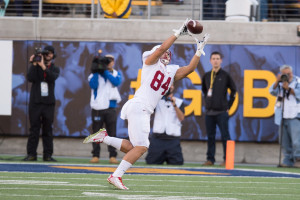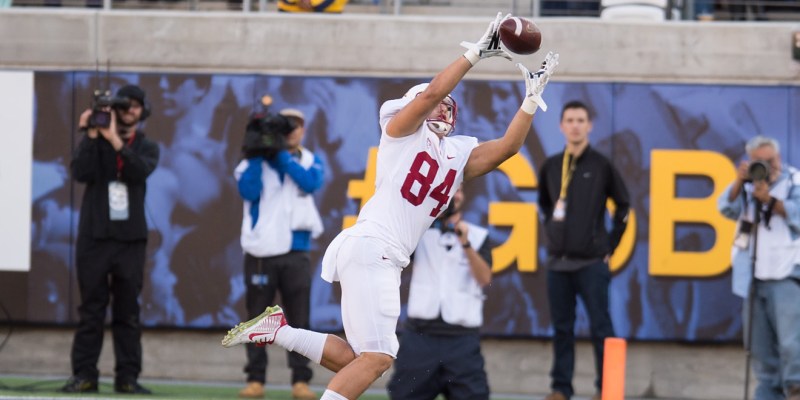In preparation for Stanford’s upcoming matchup against Oregon with the Pac-12 North title at stake yet again, The Stanford Daily’s Do-Hyoung Park (@dohyoungpark) had a chance to ask a few questions to Justin Wise (@JustinFWise), the sports editor at The Daily Emerald, to find out about the state of the Oregon program amidst a rather disappointing season.

The Stanford Daily (TSD): Is Oregon just suffering a temporary downswing, or are the Ducks on the way down? I don’t think anybody could have expected the defense to regress this badly, and with Vernon Adams transferring over, I feel like the general consensus was that the Ducks wouldn’t skip a beat. But two embarrassing home losses to Utah and Washington State later, it’s looking like Oregon’s system might not be as plug-and-play as it initially seemed, especially at quarterback.
Justin Wise (JW): It’s hard to tell. Vernon Adams was not healthy in the game against Utah and was benched by the second quarter, and then did not play a down in Oregon’s loss to Washington State. Since his return, though, the offense has looked exactly like as advertised. The unit just totaled 777 yards of offense against Cal and scored 61 points – albeit in triple overtime – against Arizona State the week earlier.
TSD: With that in mind, how do people around the program feel about Mark Helfrich? Have fans’ confidence in him taken a hit in light of this season?
JW: Twitter became a place during October for fans to not just cry for the firing of Helfrich, but also a complete overhaul of the coaching staff. But as for the vibe around the program, there has never appeared to be any uncertainty about the head coach. After all, Helfrich just guided Oregon to the national championship a year ago and is now watching arguably the greatest player in the program’s history play on Sundays this season.
TSD: After a string of nationally-relevant matchups, this will mark the second season in a row in which one team has severely underperformed coming into this game. Last year, Oregon was a huge favorite and played like it. This year, the tables are turned and Stanford is the undisputed favorite. How does that affect the Ducks’ mentality going into the game?
JW: It’s definitely something Oregon players and coaches are aware of. Offensive coordinator Scott Frost said on Monday that the underdog role is one “we’re not used to playing.” In addition, Oregon players have talked plenty about salvaging this season and winning out, and I’m sure they’re fully aware that Stanford poses the toughest challenge to doing that.
TSD: Is the defense really that bad? What’s gone wrong for the Ducks on that side of the ball? Are they going to be able to match up with Stanford’s offensive line on power runs and with Stanford’s playmakers (Christian McCaffrey and Bryce Love) in space?
JW: Oregon’s defense had possibly its best performance of the season last Saturday, but yes, it has been that bad. Its secondary is largely to blame for the struggles. After losing three starters from that group last year, filling the void has been a much more difficult process than its coaches may have expected. Its front seven is a strength of the team and is in the top half of the conference in rushing defense and sacks, but I still do not see the Ducks being able to contain Stanford’s rushing or aerial attack. What’s more, I think a tight end like Austin Hooper poses an ever bigger challenge for the Oregon secondary.
TSD: The offense has bounced back under Vernon Adams, but it still seems far from the surgically-efficient death machine that Marcus Mariota ran in the last three years. What’s changed since then?
JW: It really has to do with experience. Mariota guided the offense for three years. Adams was on campus for only a few weeks before he made his first start in a Ducks uniform. He’s clearly been learning on the fly, and it seemed he finally felt comfortable in the pocket in last Saturday’s win against Cal.
TSD: Utah held the Ducks to 20, Michigan State held them to 28 and Washington held them to 26. What’s the key to stopping Oregon’s offense? Can Stanford keep the Ducks at bay for four quarters?
JW: The key to stopping Oregon’s offense has been the same for the past several years: Stop the run. No matter how lethal a passer Mariota was, Oregon’s offense is predicated on rushing the ball, and if it can’t, it struggles to find a rhythm. Currently, that part of the offense is averaging 305 yards per game, and if it can be contained, the unit will undoubtedly struggle.
TSD: Oregon is the underdog for the first time since 2011, but Ducks fans will remember that game fondly, as Oregon came to The Farm and derailed one of the best seasons in Stanford history with a 53-30 rout. What does Oregon need to do in order to repeat history? How do you see the game panning out, and who wins?
JW: Oregon needs to march down the field the way it has in the last two weeks. It needs an efficient game from Adams, but also needs ball-carriers like Royce Freeman to help establish the tempo. On defense, it needs to be opportunistic and force turnovers. If those things happen, it’s clear that an upset could be brewing. But I don’t see the game panning out that way. Oregon has historically had trouble stopping Stanford, and the Cardinal’s strength in regards to time of possession has never boded well for Oregon. I see Oregon staying in the game early, but Stanford simply being too much to contain and running away with it in the second half.
Contact Do-Hyoung Park at dhpark ‘at’ stanford.edu and Justin Wise at jwise ‘at’ dailyemerald.com.
